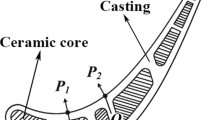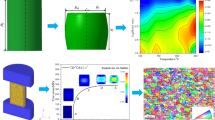Abstract
Nickel-based superalloy MM247 turbine blades produced through investment casting are widely used for aero engines and gas turbines. To control the dimensional accuracy of the blades, this study proposed a novel integrated computational framework named AICAST, implanted with the response surface methodology optimization model and multi-layer perceptron neural network. Firstly, the wax injection stage and the influence of the gating system and process parameters on the displacement field during the solidification process are simulated to predict the deformation distribution of the blade patterns. The maximum deformation of the wax pattern is then lowered by 60.39%, and the deformation of the blade casting reaches the minimum via AICAST of 0.1504 mm. The maximum prediction difference of the MLP neural network model is 0.0123 mm, and the mean absolute percentage error is 2.71%, indicating that the deformation of blade casting can be modeled and predicted. Finally, the experimental results show that the wax pattern and the blade casting meet the dimensional accuracy requirements. The largest fluctuation of the contour error is in the A3 section, which agrees with the simulation results. The proposed framework, AICAST, can give researchers new insight into integrated computational materials engineering. The framework takes the fluctuations and effects of multiple processes into account. It can also automatically operate all the script files, thereby improving the efficiency of traditional numerical simulation.

















Similar content being viewed by others
References
Dong YW, Guo X, Ye QW, Yan WG (2022) Shrinkage during solidification of complex structure castings based on convolutional neural network deformation prediction research. Int J Adv Manuf Technol 118:4073–4084. https://doi.org/10.1007/s00170-021-08137-5
Qiu F, Bu K, Song JH, Tian GL, Zhang XD (2018) Dimensional Control of Nickel-Based Single Crystal Turbine Blade Investment Casting by Process Control Optimization. Int J Met 12:469–479. https://doi.org/10.1007/s40962-017-0180-5
Chen JB, Chen JY, Wang QJ, Wu YD, Li Q, Xiao CB et al (2022) Enhanced creep resistance induced by minor Ti additions to a second generation nickel-based single crystal superalloy. Acta Mater 232:117938. https://doi.org/10.1016/j.actamat.2022.117938
Dong YW, Li XL, Zhao Q, Yang J, Dao M (2017) Modeling of shrinkage during investment casting of thin-walled hollow turbine blades. J Mater Process Technol 244:190–203. https://doi.org/10.1016/j.jmatprotec.2017.01.005
Liu CH, Jin S, Lai XM, Wang YL (2015) Dimensional variation stream modeling of investment casting process based on state space method. Proc Inst Mech Eng Part B J Eng Manuf 229:463–474. https://doi.org/10.1177/0954405414530900
Sabau AS, Cannell N (2014) Predicting Pattern Tooling and Casting Dimensions for Investment Casting - Phase II Metalcasting Industry for the Future Principal Investigators, 1–73. https://doi.org/10.2172/974578
Khade US, Sawant SM (2014) Gating Design Modification Using 3D CAD Modeling and Casting Simulation for Improving the Casting Yield. Int J Adv Mecha E 4:813–820
Nimbulkar SL, Dalu RS (2016) Design optimization of gating and feeding system through simulation technique for sand casting of wear plate. Perspect Sci 8:39–42. https://doi.org/10.1016/j.pisc.2016.03.001
Li F, Wang YC, Wang DH, Zhao YJ, Qi CK, Sun BD (2021) Comparison of various gating systems for investment casting of hydraulic retarder impeller with complex geometry. Proc IMech Part B J Eng Manuf 235:583–593. https://doi.org/10.1177/0954405420971994
Dong RZ, Wang WH, Cui K, Wang ZC, Jiang RS (2023) Core shifting prediction in filling process of hollow turbine blade investment casting. J Manuf Process 86:253–265. https://doi.org/10.1016/j.jmapro.2022.12.059
Chauhan AS, Anirudh B, Satyanarayana A, Rallapalli P (2019) FEA optimization of injection parameters in ceramic core development for investment casting of a gas turbine blade. Mater Today Proc 26:2190–2199. https://doi.org/10.1016/j.matpr.2020.02.477
Chen YH, Liao DM, Li WD, Chen T, Yang M, Shi JK (2022) Iterative reverse deformation optimization design of castings based on numerical simulation of solidification thermal stress. China Foundry 19:342–350. https://doi.org/10.1007/s41230-022-2034-x
Chen CC, Su PL, Chiou CB, Chiang KT (2011) Experimental investigation of designed parameters on dimension shrinkage of injection molded thin-wall part by integrated response surface methodology and genetic algorithm: A case study. Mater Manuf Process 26:534–540. https://doi.org/10.1080/10426914.2010.530331
Li ZL, Xiong JC, Xu QY, Li JR, Liu BC (2015) Deformation and recrystallization of single crystal nickel-based superalloys during investment casting. J Mater Process Technol 217:1–12. https://doi.org/10.1016/j.jmatprotec.2014.10.019
Sabau AS, Viswanathan S (2008) Material properties for predicting wax pattern dimensions in investment casting. Mater Sci E A 362:125–134. https://doi.org/10.1016/S0921-5093(03)00569-0
Rezavand SAM, Behravesh AH (2007) An experimental investigation on dimensional stability of injected wax patterns of gas turbine blades. J Mater Process Technol 182:580–587. https://doi.org/10.1016/j.jmatprotec.2006.09.029
Jiang RS, Zhang DH, Bu K, Wang WH, Tian JW (2017) A deformation compensation method for wax pattern die of turbine blade. Int J Adv Manuf Technol 88:3195–3203. https://doi.org/10.1007/s00170-016-9030-5
Kuo CC, Xu YX (2022) A simple method of improving warpage and cooling time of injection molded parts simultaneously. Int J Adv Manuf Technol 619–637. https://doi.org/10.1007/s00170-022-09925-3
Tian JW, Bu K, Song JH, Tian GL, Qiu F, Zhao DQ et al (2017) Optimization of investment casting process parameters to reduce warpage of turbine blade platform in DD6 alloy. China Foundry 14(6):469–477
Pollock TM, Allison JE, Backman DG et al (2008) Woodward, Integrated Computational Materials Engineering: A Transformational Discipline for Improved Competitiveness and National Security. National Materials Advisory Board, NAE, National Academies Press, Washington DC
Joost WJ (2012) Reducing vehicle weight and improving U.S. energy efficiency using integrated computational materials engineering. Jom 64:1032–1038. https://doi.org/10.1007/s11837-012-0424-z
Allison J, Li M, Wolverton C, Su XM (2006) Virtual aluminum castings: An industrial application of ICME. Jom 58:28–35. https://doi.org/10.1007/s11837-006-0224-4
Himanen L, Geurts A, Foster AS, Rinke P, Smith D, Brinson C (2019) Data-Driven Materials Science : Status , Challenges , and Perspectives. Adv Sci 6:1900808. https://doi.org/10.1002/advs.201903667
Wang Z, Sun ZH, Yin H, Liu XH, Wang JL, Zhao HT et al (2022) Data - Driven Materials Innovation and Applications. Adv Sci. https://doi.org/10.1002/adma.202104113
Wang WY, Li JS, Liu WM, Liu ZK (2019) Integrated computational materials engineering for advanced materials : A brief review. Comput Mater Sci 158:42–48. https://doi.org/10.1016/j.commatsci.2018.11.001
Panchal JH, Kalidindi SR, Mcdowell DL (2013) Key computational modeling issues in Integrated Computational Materials Engineering. Comput Des 45:4–25. https://doi.org/10.1016/j.cad.2012.06.006
Motaman SAH, Kies F, Kohnen P (2020) Optimal Design for Metal Additive Manufacturing : An Integrated Computational Materials Engineering ( ICME ) Approach. APICAM 72:27–34. https://doi.org/10.1007/s11837-020-04028-4
Huang ZK, Shi RH, Xiao XY, Fu HD, Chen Q, Xie JX (2021) Mechanism investigation on high-performance Cu-Cr-Ti alloy via integrated computational materials engineering. Mater Today Commun 27:102378. https://doi.org/10.1016/j.mtcomm.2021.102378
Bolcavage A, Brown PD, Cedoz R, Cooper N, Deaton C, Hartman DR et al (2014) Integrated computational materials engineering from a gas turbine engine perspective. Inter Mater Manuf Innov 3:13
Olson GB (1997) Computational Design of Hierarchically Structured Materials. Science 277(5330):1237–1242. https://doi.org/10.1126/science.277.5330.1237
Agrawal A, Choudhary A (2016) Perspective : Materials informatics and big data : Realization of the “ fourth paradigm ” of science in materials science APL. Mater 4:053208. https://doi.org/10.1063/1.4946894
Jalalahmadi B, Liu J, Liu Z et al (2021) An Integrated Computational Materials Engineering Predictive Platform for Fatigue Prediction and Qualification of Metallic Parts Built With Additive Manufacturing. J Tribo J-T Asme 143:051112–051111. https://doi.org/10.1115/1.4050941
Chang XY, Shen Q, Fan WX, Hao H (2022) Optimization of Magnesium Alloy Casting Process : An Integrated Optimization of Magnesium Alloy Casting Process : An Integrated Computational Materials Engineering ( ICME ) Approach. Mater Sci Forum 1035:808–812. https://doi.org/10.4028/www.scientific.net/MSF.1035.808
Wang GJ, Peng LY, Li KQ, Zhu LG, Zhou J, Miao NH et al (2021) ALKEMIE : An intelligent computational platform for accelerating materials discovery and design. Comput Mater Sci 186:110064. https://doi.org/10.1016/j.commatsci.2020.110064
Yan XW, Guo X, Liu YL et al (2019) Numerical simulation of dendrite growth in Ni-based superalloy casting during directional solidification process. Trans Nonferrous Met Soc China 29:338–348. https://doi.org/10.1016/S1003-6326(19)64943-5
Pattnaik S, Karunakar DB, Jha PK (2012) Journal of Materials Processing Technology Developments in investment casting process — A review. J Mater Process Tech 212:2332–2348. https://doi.org/10.1016/j.jmatprotec.2012.06.003
Yilmaz I, Kaynar O (2011) Multiple regression, ANN ( RBF, MLP ) and ANFIS models for prediction of swell potential of clayey soils. Expert Syst Appl 38:5958–5966. https://doi.org/10.1016/j.eswa.2010.11.027
Abbaskhah A, Sedighi H, Akbarzadeh P, Salavatipour A (2023) Optimization of horizontal axis wind turbine performance with the dimpled blades by using CNN and MLP models. Ocean Eng 276:114185. https://doi.org/10.1016/j.oceaneng.2023.114185
Abbaskhah A, Sedighi H, Marvi H (2023) Infant cry classification by MFCC feature extraction with MLP and CNN structures. Biomed Signal Process Control 86:105261. https://doi.org/10.1016/j.bspc.2023.105261
Funding
This work was financially supported by the National Key Research and Development Program of China (2020YFB1710100,2022YFB3706800), the National Science and Technology Major Projects of China(J2019-VI-0004-0117), the National Natural Science Foundation of China (51821001,52074183,52090042), the Major State Basic Research Development Program of Zhejiang (2020C01056,2021C01157,2022C01147), and Open Fund of State Key Laboratory of Long Life High Temperature Materials (DECSKL202109).
Author information
Authors and Affiliations
Contributions
All authors contributed to the study conception and design. Simulation data and the first draft of the manuscript were prepared by Leyao Zhou. Experimental data collection was performed by Daiyin Zhao. All authors read and approved the final manuscript.
Corresponding author
Ethics declarations
Ethical approval
This paper is the latest research. Neither the entire paper nor any part of its content has been published or has been accepted elsewhere. It is not being submitted to any other journal as well.
Consent to participate
Not applicable
Consent for publication
Not applicable
Competing interests
The authors declare no competing interests.
Additional information
Publisher’s note
Springer Nature remains neutral with regard to jurisdictional claims in published maps and institutional affiliations.
Rights and permissions
Springer Nature or its licensor (e.g. a society or other partner) holds exclusive rights to this article under a publishing agreement with the author(s) or other rightsholder(s); author self-archiving of the accepted manuscript version of this article is solely governed by the terms of such publishing agreement and applicable law.
About this article
Cite this article
Zhao, D., Zhou, L., Wang, D. et al. Integrated computational framework for controlling dimensional accuracy of thin-walled turbine blades during investment casting. Int J Adv Manuf Technol 129, 1315–1328 (2023). https://doi.org/10.1007/s00170-023-12319-8
Received:
Accepted:
Published:
Issue Date:
DOI: https://doi.org/10.1007/s00170-023-12319-8




